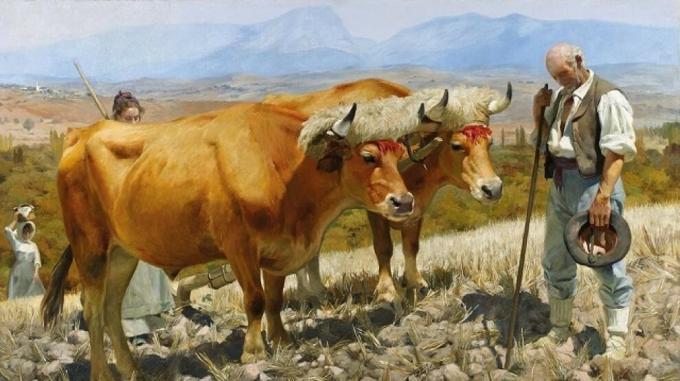Is there an art objectively better than another?
We all know that art, like so many things, is subjective. However, Is there an art objectively better than another? Can we find an artistic style or a time in which its artistic manifestation is, objectively, better than the others?
We propose a walk through the history of art to unravel if there really is an art that is objectively better than another.
- Related article: "The 8 branches of the Humanities (and what each of them studies)"
Is there an objectively better art?
During some periods of history this has certainly been believed. That is why, during the Renaissance, authors such as Vasari belittled Gothic art and labeled it "barbaric" art (Gothic art, which is where its name comes from). The Baroque was also another of the much reviled styles with the advent of the French Revolution and classicism. But what reason was there for these considerations?
The reason was none other than the change in mentality and, therefore, the appearance of prejudices. In Vasari's time, the Renaissance had taken over the arts, so everything that did not fit into a "classicist" vision was considered a minor, less evolved art. The same thing happened centuries later with the Baroque and, especially, the Rococo. The French revolutionaries saw the latter as the art of the nobility and therefore an art that had to be destroyed.
So To what extent are artistic evaluations subject to prejudice?
- You may be interested in: "The 10 branches of Philosophy (and their main thinkers)"
But what is art, exactly?
Here we need to introduce a clarification. What is the art? A definition as multiple as it is complex (and complicated). The Royal Spanish Academy offers various definitions of the word. Among them are the following: "Capacity, ability to do something", and "Manifestation of activity through which what is real is interpreted or what is imagined is captured with plastic, linguistic or voiced”. We believe that, in the second sense, the RAE has hit the nail on the head. Let's see it carefully: "... through which what is real is interpreted or what is imagined is captured." It is clear: art has two paths: the representation of reality (sometimes strictly, as we will see later) or the embodiment of transcendent concepts. In addition, we must add that both things are not at odds with each other, although they make us believe so.
For his part, the eminent E. H Gombrich, in his famous art history, he begins his introduction by asserting that: “Art does not really exist. There are only artists. These were once men who took colored earth and roughly drew the shapes of a bison on the walls of a cave; today, they buy their colors and draw signs for the subway stations”. And then he adds: “There is no harm in calling all these activities art, as long as we keep in mind that such a word can mean many different things, in different times and places, and while we notice that Art, written the word with a capital A, does not exist, since Art with a capital A has by essence to be a ghost and an idol…”.

In other words, for the prestigious historian, if only artists exist and, therefore, there is no ideal of art (that Art with capital letter that comments), then it means that, indeed, there is no artistic style or era better or worse than others. To carry out this brief trip, it will be very helpful to rely on concrete examples; in this way it will be much easier to understand what Gombrich meant by such a statement.
- Related article: "What are the 7 Fine Arts? A summary of its characteristics"
Composition, shape, perspective
Let's take the bison that Gombrich comments on as an example. You all have in mind the typical prehistoric painting, made in the shelter of a cave. Let's throw a question. Is this representation realistic? Do not hesitate to answer, because the answer is "no".
The artist who painted the bison did not intend to represent a real bison, with its volumes, its perspective and its realistic details. Indeed, there is no perspective at all; the drawing is completely flat (although, in some examples, marked attempts at realism can be noted). In any case, the result is the same: the animal depicted on the wall or ceiling of the cave represents an idea, a concept, not a real bison.
Let's compare the prehistoric bison with a 19th century painting; For example, Angelus prayer in the field, by the painter Ignacio Díaz Olano from Vitoria.

We will observe that, on the canvas, the painter has made a meticulous representation, practically photographic, from the anatomy of two oxen. The volumes are perfect, the perspective is adequate; we have the sensation of being present in the scene, as if we were part of the instant represented. In a word: Díaz Olano is capturing a fragment of reality.
At this point, we ask a question. Is Díaz Olano's team objectively better? In terms of resolution, drawing, perspective and technique, of course yes. The perspective, the volumes, the realistic tones of the painting; they have nothing to do with the flat figure, in neutral colors, that we saw on the wall of the cave. Now, does this mean that Díaz Olano's work is objectively better, in general, than the prehistoric bison? The answer, in this case, would undoubtedly be “no”.
- You may be interested in: "The 10 branches of Philosophy (and their main thinkers)"
The expression, the concept, the idea
Let's take another example that will illustrate very well what we mean. And it is none other than The executions of May 3, from Goya.

Good. Now compare it with another shooting scene: Execution of Torrijos and his companions on the beaches of Malagaby Antonio Gisbert.

Let's start with the second. In Torrijos, everything is perfect. Again, the composition has no fault; nor the perspective, nor the volumes, nor the drawing, nor the technique. It is, formally speaking, a perfect painting. In addition, Gisbert also introduces expression into his work: if we look carefully, each of the faces of those who are going to die express a different feeling, ranging from the most excruciating fear to the most amazing.
Let's go now to Goya's executions. Can we say that, formally, Torrijos is better resolved? Well, despite talking about Goya, the answer is once again “yes”. Gisbert's canvas is a photographic snapshotCapturing a real moment in life. Again, and as with the angelus of Díaz Olano, it seems that we are on the beach, with Torrijos and his companions. In fact, what is really exciting about the painting is that it seems that we are part of the group of prisoners waiting their turn to die, given the point where the viewer's view is located. As for the faces, nothing more to say; Gisbert took notes on original portraits of the victims, and also met with relatives of the deceased in order to faithfully recreate the features of those executed.
Now, if we go to Goya's painting, we will see that the faces are not identifiable. To begin with, the French (the executioners) hide their faces, as if they were ashamed. In addition, most of those shot cover their faces with their hands. The few that show their faces seem to us to be Carnival or nightmare masks rather than human beings. There are no individualized factions; Goya is painting terror in its purest form.
Let's go then to the question. Does this mean that Gisbert's painting is objectively better than Goya's? Obviously not. And because? Because, quite simply, Gisbert's intention when carrying out his Torrijos was not the same as Goya's when he painted his executions. The first wanted to show impeccable reality, while the second he expressed his anger and his frustration through the brush. Gisbert did not experience the firing squad of Torrijos; what's more, he painted the picture several decades later. Goya did live those fateful days of May.
- Related article: "What is creativity? Are we all "would-be geniuses"?"
The ballast of academicism
Beginning in the 18th century and, above all, in the 19th century, academic art (such as the painting of Torrijos) is considered the zenith of painting and sculpture. The perfect composition, the resolution of a seamless perspective, the correct proportion between characters... scholarly works do not actually have any formal errors to point to.
However, it is no less true that during the 19th century the expression and the idea were forgotten. In other words, the "what" was diluted, and only the "how" remained. Very contrary to what had been other "arts" in history, where what had prevailed above all else was the concept, the idea that was represented. This is one of the reasons why, among others, medieval art has been largely despised since the 18th century; his conceptual, transcendent style did not fit with the prevailing academicism.
If we want to correctly value a work of art, we must keep in mind that in our appreciation we carry the ballast of Academicism. And be careful, because we do not mean by this that academic art is bad, on the contrary; but it is true that for many years we have been taught that the only "good" art is one that respects the formal guidelines of perspective, volume and composition, among others things. And this, of course, makes us lose our way and we are not in a position to value the other "arts" which, of course, have value in themselves.
Because the guidelines that are needed to value a work are not only those that the Academy has been dictating to us for centuries. There are others, such as expressiveness, feeling and idea which, on the other hand, are the ones that dictated the art of other times and cultures. Should we believe that a Romanesque Madonna and Child is “worse” than a Venus by Praxiteles? Of course not. They are daughters of two concepts and two very, very different worlds.
However, and like everything related to art, the decision is up to each one. In this article we only propose a different look and, above all, suitable for each specific work; a look that takes into account the context, the technical possibilities and the personality of the author.



